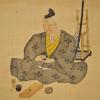Hi Patrick,
Instead of focusing on Zen, look into Japanese Buddhism in general, as there were Bushi that practiced other forms of Buddhism such as Mikkyo and Nichiren. The place to start is to consider the time periods when Buddhism was culturally dominant. In regard to the tsuba that you can find, this would be the Muromachi, Momoyama and Early Edo periods. Later on in the Mid to Late Edo periods the dominant influence was the Neo Confucianism instituted by the Tokugawa, so you will not find as many Buddhist influenced tsuba from those periods.
There are a lot of tsuba with Buddhist subject matter such as the Wheel of Law, Temple Bells, Cha no Yu utensils, etc. that are about Buddhism, but then there are also tsuba that are Buddhist, in that they demonstrate Emptiness (Ku) – by expressing Process, Relationship and Transformation; and so they are intentionally ambiguous, contradictory and incomplete. This attempt to express a Buddhist view of reality by adopting the visual conventions developed by Cha no Yu Tea Masters is where the Kanayama and other “Tea” type tsuba of the Momyama and Early Edo periods come from.
Some further reading on Cha no Yu and Ku
http://www.anthropoetics.ucla.edu/ap0501/tea.htm
http://www.stephenbatchelor.org/index.p ... tmodernity
Tim Evans


